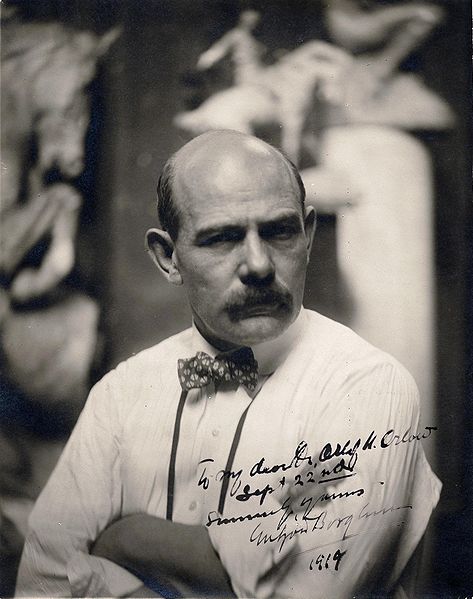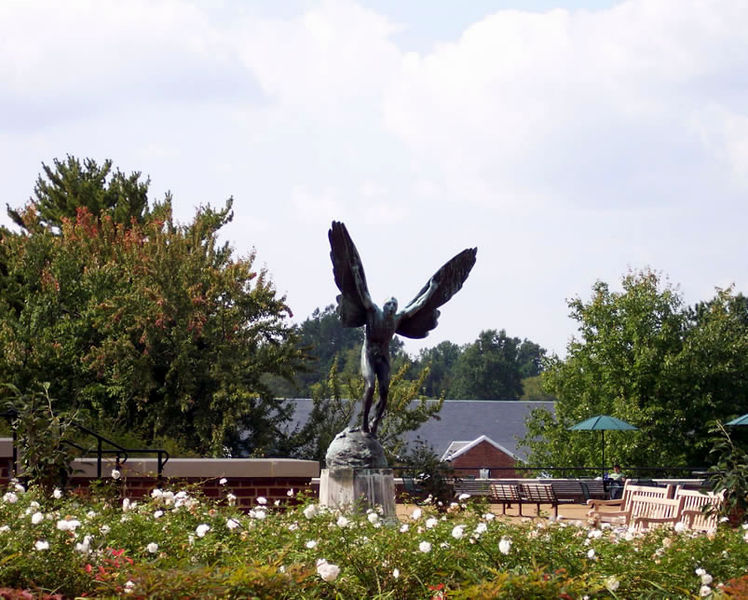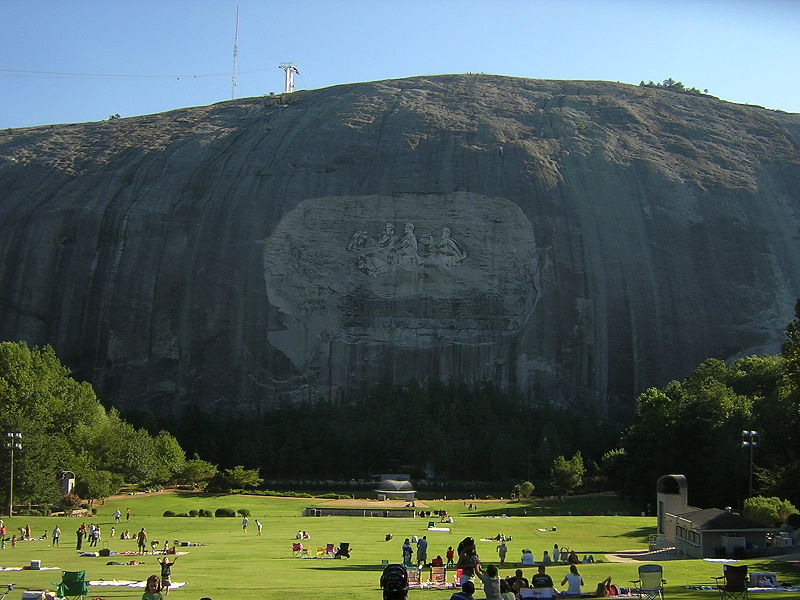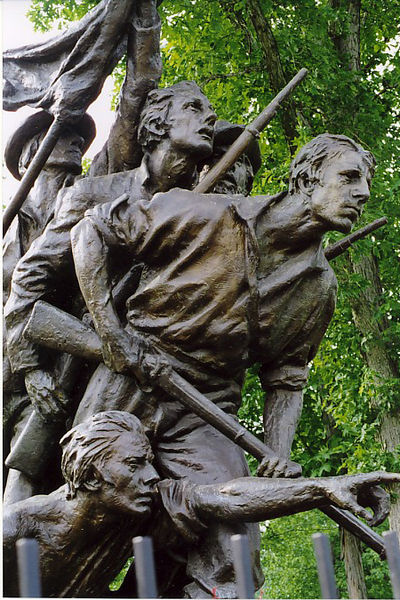<Back to Index>
- Mathematician and Astronomer Christopher Clavius, 1538
- Sculptor John Gutzon de la Mothe Borglum, 1867
- King of Napoli Joachim-Napoléon Murat, 1767

(John) Gutzon de la Mothe Borglum (March 25, 1867 – March 6, 1941) was an American artist and sculptor famous for creating the monumental presidents' heads at Mount Rushmore, South Dakota, the famous carving on Stone Mountain near Atlanta, as well as other public works of art.
The son of Danish immigrants, Gutzon Borglum was born in 1867 in St. Charles, Idaho. His father worked mainly as a woodcarver. A commemorative inscription stands near the center of the town. At the age of seven, he moved to Nebraska, and later graduated from Creighton Preparatory School. He was trained in Paris at the Académie Julian, where he came to know Auguste Rodin and was influenced by Rodin's impressionistic light-catching surfaces. Back in the U.S. in New York City he sculpted saints and apostles for the new Cathedral of Saint John the Divine in 1901, got a sculpture accepted by the Metropolitan Museum of Art— the first sculpture by a living American the museum had ever purchased—and made his presence further felt with some portraits. He also won the Logan Medal of the arts.
After graduation from Harvard Technical College, his reputation surpassed that of his younger brother, Solon Borglum, already an established sculptor.
A fascination with gigantic scale and themes of heroic nationalism suited his extroverted personality. His head of Abraham Lincoln, carved from a six-ton block of marble, was exhibited in Theodore Roosevelt's White House and can be found in the Capitol Rotunda in Washington, D.C. A
patriot, believing that the "monuments we have built are not our own,"
he looked to create art that was "American, drawn from American
sources, memorializing American achievement" according to a 1908
interview article. His equation of being "American" with being born of
American parents—"flesh of our flesh"—was characteristic of nativist beliefs
in the early 20th century. Borglum was highly suited to the competitive
environment surrounding the contracts for public buildings and
monuments, and his public sculpture is sited all around the United
States. In 1908, Borglum won a competition for a statue of the Civil War General Philip Sheridan to be placed in Sheridan Circle in Washington. D.C. A second version was erected in Chicago, Illinois in 1923. Winning this competition was a personal triumph for him because he won out over sculptor J.Q.A.Ward, a much older and more established artist, and one whom Borglum had clashed with earlier in regard to the National Sculpture Society.
At the unveiling of the Sheridan one critic, President Theodore
Roosevelt (whom Borglum was later to put on Mount Rushmore) declared
that it was "first rate," and another critic was to state that, "as a
sculptor Gutzon Borglum was no longer a rumor, he was a fact." Borglum was active in the committee that organized the New York Armory Show of 1913, the birthplace of modernism in
American art. But by the time the show was ready to open, Borglum
resigned from the committee, feeling that the emphasis on avant-garde
works had co-opted the original premise of the show and made
traditional artists like himself look provincial. He lived in Stamford, Connecticut for 10 years. Borglum's nativist stances made him seem an ideologically sympathetic choice to carve a memorial to heroes of the Confederacy, planned for Stone Mountain, Georgia. In 1915, he was approached by the United Daughters of the Confederacy with a project for sculpting a 20-foot (6 m) high bust of General Robert E. Lee on the mountain's 800-foot (240 m) rock face. Borglum accepted, but told the committee, "Ladies, a twenty foot head of Lee on that mountainside would look like a postage stamp on a barn door." Borglum's ideas eventually evolved into a high-relief frieze of Lee, Jefferson Davis, and 'Stonewall' Jackson riding around the mountain, followed by a legion of artillery troops. After a delay caused by World War I,
Borglum and the newly-chartered Stone Mountain Confederate Monumental
Association set to work on this unexampled monument, the size of which
had never been attempted before. Many difficulties slowed progress,
some because of the sheer scale involved. After finishing the detailed
model of the carving, Borglum was unable to trace the figures onto the
massive area on which he was working, until he developed a gigantic magic lantern to project the image onto the side of the mountain. His Mount Rushmore project, 1927-1941, was the brainchild of South Dakota state historian Doane Robinson.
His first attempt with one of the faces was blown up after two years.
Dynamite was also used to remove large areas of rock from under
Washington's brow. The initial pair of presidents, George Washington and Abraham Lincoln was soon joined by Thomas Jefferson, for this monument sited in the sacred Native American heartland of the Louisiana Purchase, and to make the theme of Manifest Destiny perfectly clear, Theodore Roosevelt. Borglum alternated exhausting on-site supervising with world tours, raising money, polishing his personal legend, sculpting a Thomas Paine memorial for Paris and a Woodrow Wilson one for Poland. In his absence, work at Mount Rushmore was overseen by his son Lincoln.
During the Rushmore project, father and son were residents of Beeville,
Texas. When he died in Chicago, following complications after surgery,
his son finished another season at Rushmore, but left the monument
largely in the state of completion it had reached under his father's
direction. In 1908, Borglum completed the statue of John William Mackay (1831-1902), a Comstock Lode silver baron. The statue is located at the University of Nevada, Reno. One
of Borglum's more unusual pieces is the "Aviator", completed in 1919 as
a memorial for James R. McConnell, who was killed in World War I while
flying for the Lafayette Escadrille. It is located on the grounds of the University of Virginia in Charlottesville, Virginia. Another impressive Borglum design is the North Carolina state monument on Seminary Ridge at the Gettysburg Battlefield in south-central Pennsylvania. The cast bronze sculpture depicts a wounded Confederate officer encouraging his men to push forward during Pickett's Charge. With dramatic flair, Borglum had made arrangements for an airplane to
fly over the monument during the dedication ceremony on July 3, 1929.
During the sculpture's unveiling, the plane scattered roses across the
field as a salute to those North Carolinians who had fought and died at
Gettysburg. Four public works by Borglum are in Newark, NJ: Abraham Lincoln, The Indian and the Puritan, Wars of America, and a small relief of the founding of the city. Borglum was an active member of the Ancient Free and Accepted Masons (the Freemasons),
raised in Howard Lodge #35, New York City, on June 10, 1904, and
serving as its Worshipful Master 1910-11. In 1915, he was appointed
Grand Representative of the Grand Lodge of Denmark near the Grand Lodge
of New York. He received his Scottish Rite Degrees in the New York City
Consistory on October 25, 1907. Borglum was a member of the Ku Klux Klan. He
sat on the Imperial Koncilium in 1923, which transferred leadership of
The Ku Klux Klan from Imperial Wizard Colonel Simmons to Imperial
Wizard Hiram Evans. Later, he stated, "I am not a member of the Kloncilium, nor a knight of the KKK", but Shaff and Shaff add, "that was for public consumption." The museum at Mount Rushmore displays a letter to Borglum from D. C. Stephenson, the infamous Klan Grand Dragon who was later convicted of the rape and murder of Madge Oberholtzer. Borglum is buried at Forest Lawn Memorial Park Cemetery in Glendale in
the Memorial Court of Honor. His second wife, Mary Montgomery Williams
Borglum, 1874–1955 (they were married May 20, 1909) is interred
alongside him. In addition to his son, Lincoln, he had a daughter, Mary
Ellis (Mel) Borglum Vhay (1916-2002). In 1938 Borglum also sculpted the Memorial to the "Start Westward of the United States" which is located in Marietta, Ohio. He also built the statue of Daniel Butterfield in Sakura Park, Manhattan. He also did a memorial to Sacco and Vanzetti (1928), which is now in the Boston Public Library.
Carving
officially began on June 23, 1923, with Borglum making the first cut.
At Stone Mountain he developed sympathetic connections with the
reorganized Ku Klux Klan,
who were major financial backers for the monument. Lee's head was
unveiled on Lee's birthday January 19, 1924, to a large crowd, but soon
thereafter Borglum was increasingly at odds with the officials of the
Association. His domineering, perfectionist, irascible, authoritarian
manner brought tensions to such a point that in March 1925 Borglum
smashed his clay and plaster models, and he left Georgia permanently.
His tenure with the association was over. None of his work remains, as
it was all cleared from the mountain's face for the work of Augustus Lukeman,
Borglum's replacement, but in his abortive attempt, Borglum had
developed necessary techniques for sculpting on a gigantic scale that
made Mount Rushmore possible.



